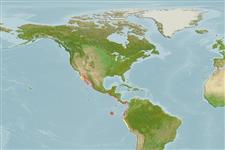Common names from other countries
Environment: milieu / climate zone / depth range / distribution range
Ecología
marino demersal. Subtropical; 33°N - 18°S, 119°W - 70°W
Eastern Pacific: San Clemente in southern California, USA to Peru, including the Galapagos Islands; rare north of Baja California, Mexico.
Tamaño / Peso / Age
Maturity: Lm ? range ? - ? cm
Max length : 163 cm FL macho / no sexado; (Ref. 40637); common length : 60.0 cm TL macho / no sexado; (Ref. 9326); peso máximo publicado: 51.7 kg (Ref. 4699)
Inhabits shallow inshore areas, frequents sandy shores along beaches. Juveniles occurs in tide pools. Exploited on a local level and marketed fresh (Ref. 9324).
Life cycle and mating behavior
Madurez | Reproducción | Puesta | Huevos | Fecundidad | Larva
Eschmeyer, W.N., E.S. Herald and H. Hammann, 1983. A field guide to Pacific coast fishes of North America. Boston (MA, USA): Houghton Mifflin Company. xii+336 p. (Ref. 2850)
IUCN Red List Status (Ref. 130435)
CITES (Ref. 128078)
Not Evaluated
Threat to humans
Harmless
Human uses
Pesquerías: escaso valor comercial; pesca deportiva: si
Más información
ReferenciasAcuiculturaPerfil de acuiculturaRazasGenéticaElectrophoresesheritabilidadEnfermedadesProcesamientoMass conversion
ColaboradoresImágenesStamps, Coins Misc.SonidosCiguateraVelocidadTipo de nataciónSuperficie branquialOtolitosCerebrosVisión
Herramientas
Special reports
Download XML
Fuentes de Internet
Estimates based on models
Preferred temperature (Ref.
115969): 20.7 - 28.5, mean 25.8 (based on 56 cells).
Phylogenetic diversity index (Ref.
82804): PD
50 = 1.5000 [Uniqueness, from 0.5 = low to 2.0 = high].
Bayesian length-weight: a=0.01072 (0.00421 - 0.02727), b=3.02 (2.80 - 3.24), in cm Total Length, based on LWR estimates for this (Sub)family-body shape (Ref.
93245).
Nivel trófico (Ref.
69278): 4.5 ±0.80 se; based on food items.
Fishing Vulnerability (Ref.
59153): Very high vulnerability (90 of 100).
